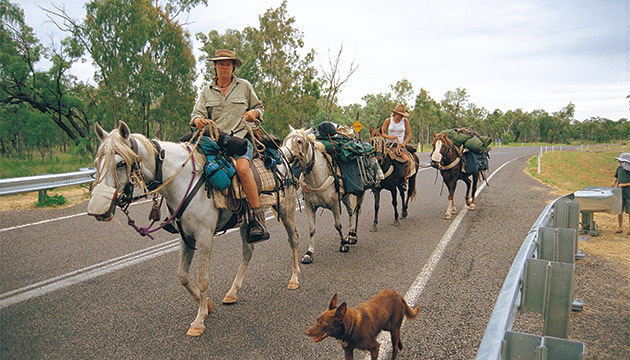Heidi Douglas has packed her life into a few saddlebags to spend two years riding horses and camels around Australia.
Story By Fiona Lake
One can only wonder what the early explorers would say if they could see the solitary woman confidently riding through the bush while reading emails on her phone. Her journey even surprises today’s travellers, with truck and train drivers keeping a solicitous eye on her progress, discussing it over the radio (“Where’s that sheila up to now?”) and waving enthusiastically whenever they pass.
“Everything I have done has led to this,” says Riverina girl Heidi Douglas, five months into her two-year round-Australia ride. These days it might seem relatively simple to ride around Australia with a few neddies and a watchdog, stocking up on fresh fruit in supermarkets along the way. But for a long-term journey to succeed it still takes a lot of planning – in Heidi’s case a couple of solid years – and even the best laid plans can go awry.
Just three weeks after starting out on the Bicentennial Trail from Victoria’s Healesville in October, three of Heidi’s four horses had to be put down while being professionally transported to Sydney to make up for time lost due to one horse going lame. Their fatal illness was probably caused by salmonella in feed given to them in the earliest leg of transport. Vet bills and transportation cost $7,000.
Heidi first dreamed of riding around Australia when in boarding school and is not the sort to give up when difficulties arise. Since finishing school in 1984 she has worked as a jillaroo and a waitress, qualified as a vet then an animal chiropractic practitioner, completed a year of an aeronautical engineering degree, gained her commercial pilot’s license and recovered from the disappointment of narrowly missing out on graduating into the RAAF.
Heidi had organised to pick up some camels in Mount Isa at the end of the wet season so she had to quickly find some replacement horses. She saved two from becoming dog’s meat by bidding on them at the Echuca horsesales, near the family farm where she grew up at Caldwell, and a third was found by word of mouth. The fourth horse is the original “tough little Arab mare, that just keeps going” (and the one who went lame while part of the first group).
Heidi says the new three are more ideal types than the previous lot, being “short and fat”. Larger horses usually require more feeding so are not as efficient. All four can be ridden or packed so can be rotated if sore. In early January the horses were floated to Bundaberg to make up for lost time, however, with creeks and rivers unusually dry it was decided to set out further north at Marlborough, near Rockhampton.
This story excerpt is from Issue #53
Outback Magazine: June/July 2007









